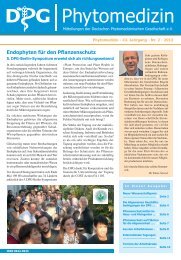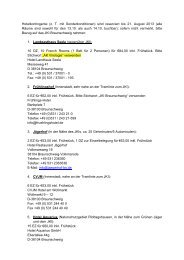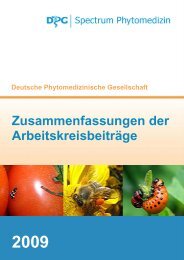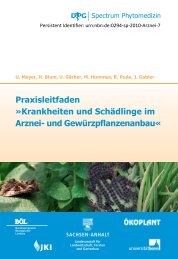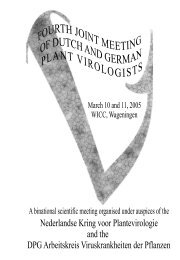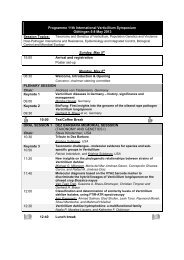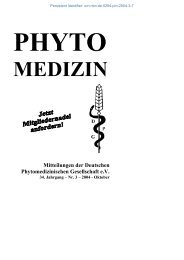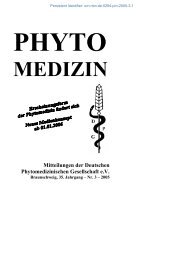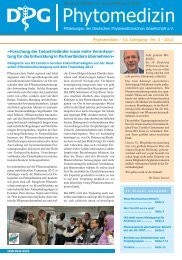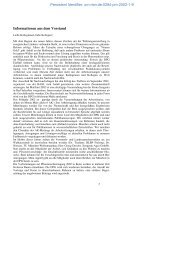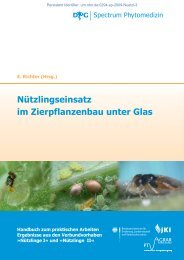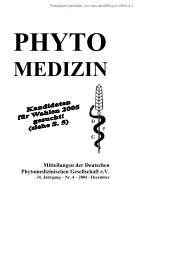Zusammenfassungen der Arbeitskreisbeiträge - Die DPG
Zusammenfassungen der Arbeitskreisbeiträge - Die DPG
Zusammenfassungen der Arbeitskreisbeiträge - Die DPG
Erfolgreiche ePaper selbst erstellen
Machen Sie aus Ihren PDF Publikationen ein blätterbares Flipbook mit unserer einzigartigen Google optimierten e-Paper Software.
whereas type A trichothecene producing species such as F. sporotrichioides and F.<br />
langsethiae are more frequent. This shift in the spectrum of Fusarium species compared to<br />
wheat does have consequences on contamination of grains with mycotoxins.<br />
Artificial inoculation experiments un<strong>der</strong> field-conditions were carried out to further<br />
investigate the impact of different Fusarium species on pathology, grain infestation and<br />
mycotoxin contamination in spring-barley. The appearance of the disease varied strongly<br />
between different species and there was no general correlation detectable between the extent<br />
of visual symptoms or grain-infestation and mycotoxin-contaminations in harvested grains.<br />
PHYLOGENIE DER GATTUNG UROCYSTIS<br />
Lotze-Engelhard, Sascha 1 ; Martin Kemler 2 , Dominik Begerow 1<br />
1 Ruhr-Universität Bochum, Fakultät für Biologie und Biotechnologie, AG Geobotanik,<br />
Universitätsstraße 150, 44801 Bochum, Germany<br />
2 Centre in Excellence in Tree Health Biotechnology Forestry and Agricultural Biotechnology<br />
Institute (FABI), University of Pretoria, Pretoria 0002, South Africa<br />
Contact: Sascha.Lotze-Engelhard@rub.de<br />
Phylogeny of the genus Urocystis<br />
The genus Urocystis Rabenhorst, which belongs to the Urocystales (Ustilaginomycotina),<br />
comprises about 140 species and appears to be morphologically well defined. However,<br />
molecular phylogenetic studies have shown that the monophyly could be questioned, and that<br />
some other genera are at least closely related.<br />
In the research summarised here, around 25% of the known species of the genus Urocystis<br />
have been studied by molecular phylogenetic methods and presented in a comprehensive<br />
analysis for the first time. The aim of this research was to elucidate the phylogeny of the<br />
genus Urocystis. Therefore we used the genetic markers ITS, LSU and TEF1. The sequence<br />
data formed the basis for the multi-gene analysis in which neighbour-joining, maximum<br />
parsimony, maximum likelihood and bayesian interference were applied.<br />
Overall, the results were concise, showing several monophyletic groups representing<br />
Urocystis species on closely related host species. However, some genera that lack spore balls<br />
of the Urocystis-type were mixed within the genus Urocystis and the backbone was not<br />
always well resolved. As traditional genus description of spore balls did not support the<br />
molecular phylogeny, we analysed the morphology of the spore balls in more detail. The<br />
spores were categorized due to their number of fertile cells and checked against the<br />
phylogenetic hypotheses obtained in the various analyses. With our data it is not possible to<br />
resolve the phylogeny of the genus Urocystis completely, but it was clearly shown that the<br />
genus Urocystis is paraphyletic in its present description because the genera Melanoxa,<br />
Mundkurella, Ustacystis and Vankya cluster in the genus Urocystis.<br />
Thus the new results raise far-reaching questions about the systematics of the whole complex<br />
of genera Urocystis, Melanoxa, Mundkurella, Ustacystis and Vankya.<br />
LIVING COLORS IN THE GRAY MOLD PATHOGEN: CODON-OPTIMIZED<br />
GENES ENCODING GFP AND MCHERRY SHOWING BRIGHT FLUORESCENCE<br />
IN BOTRYTIS CINEREA<br />
Leroch, Michaela 1 ; Dennis Mernke 1 , <strong>Die</strong>ter Koppenhoefer 1 , Prisca Schnei<strong>der</strong> 1 , Andreas<br />
Mosbach 1 , Gunther Doehlemann 2 , Matthias Hahn 1<br />
1<br />
Department of Biology, University of Kaiserslautern, Kaiserslautern, Germany<br />
2<br />
Max Planck Institute for Terrestrial Microbiology, Marburg, Germany<br />
Contact: mleroch@rhrk.uni-kl.de<br />
��



